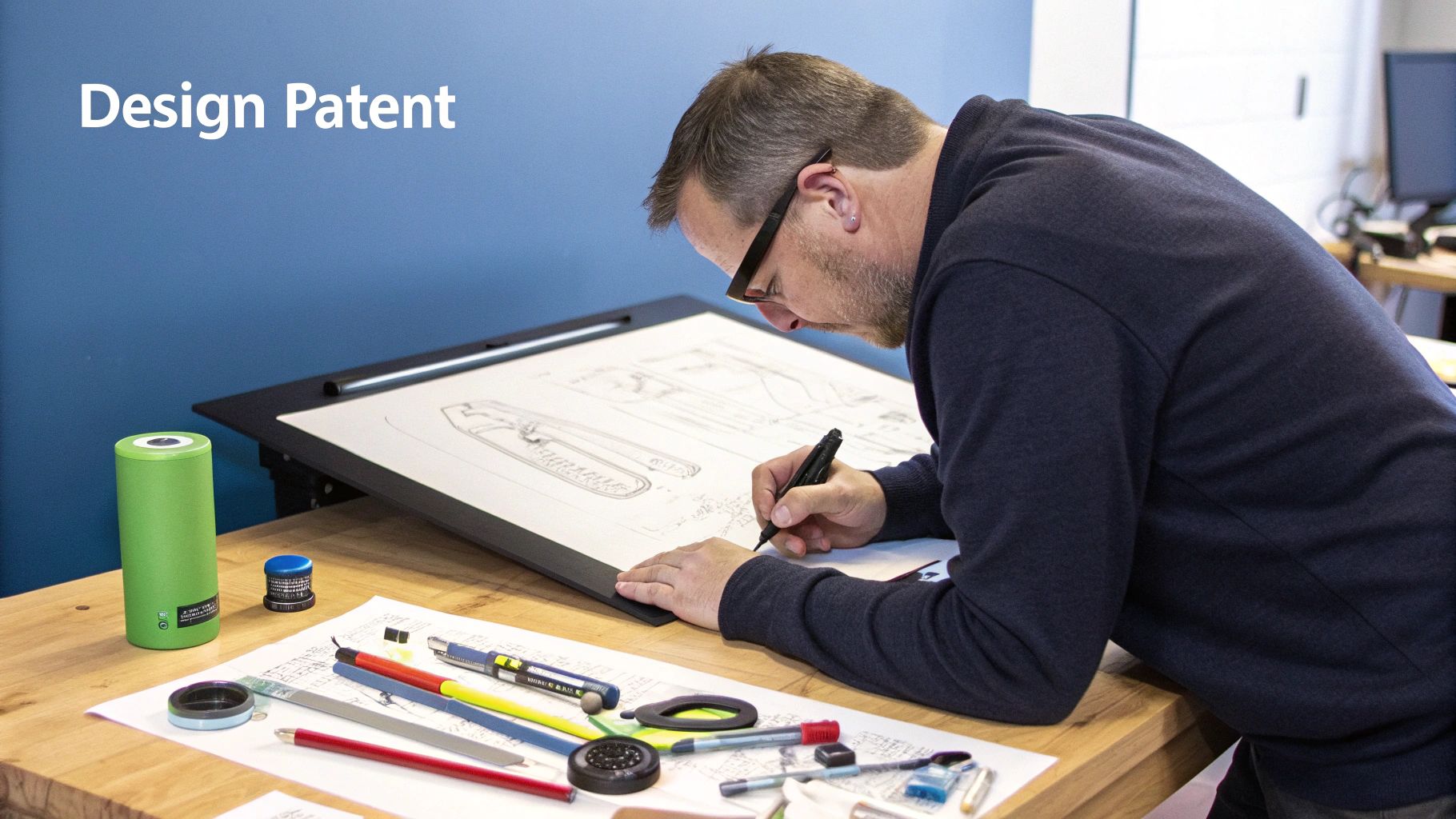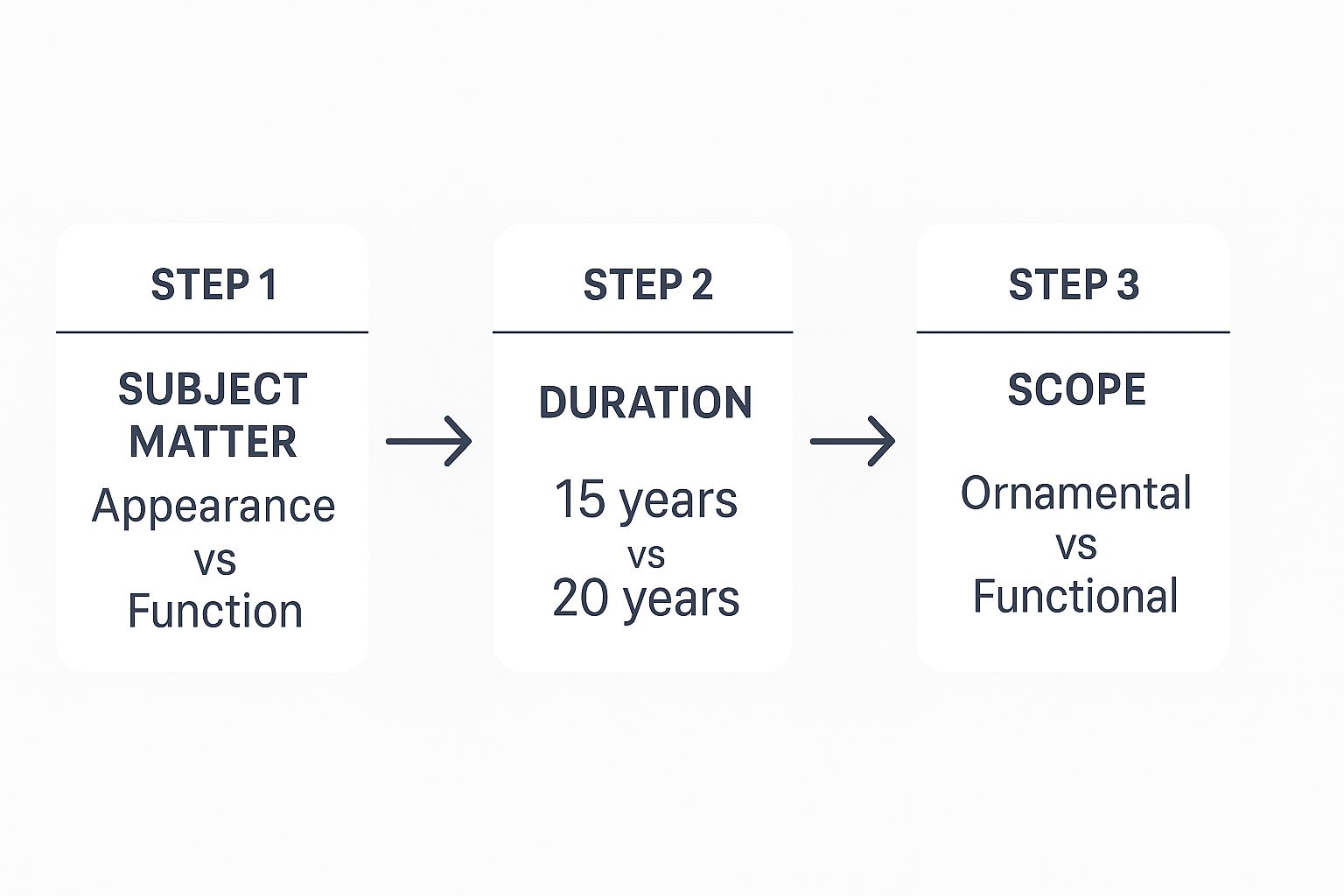Let’s get right to it. The core difference between a design and a utility patent is pretty straightforward: a utility patent protects how something works, while a design patent protects how something looks.
It’s the classic distinction between function and form. This single split defines two completely different paths for protecting your intellectual property, and understanding which one to take is everything.
Understanding the Fundamental Split

When you invent something, you’ve really created two things at once: a functional concept and a visual one. The patent system recognizes this by splitting them into separate categories, each with its own set of rules, purpose, and term of protection. Picking the right one—or sometimes, both—is critical if you want to properly safeguard your creation from competitors.
A utility patent is the heavyweight of intellectual property. It’s the one that covers new and useful processes, machines, articles of manufacture, or compositions of matter. Think of it as protecting the internal engine of your invention. It stops others from making, using, or selling a product that does the same thing, even if their version looks totally different from yours.
A design patent, on the other hand, is all about the aesthetics. It protects the unique, ornamental, and non-functional appearance of a product. This could be its specific shape, its configuration, or any surface ornamentation. This is your shield against the visual copycats who try to ride your coattails by making their product look just like your distinctive one.
The easiest way I tell clients to remember the difference is to ask themselves: "Is the most valuable part of my invention its unique function or its unique appearance?" Your answer points directly to the type of protection you need most.
To make this crystal clear, let’s put them side-by-side.
Design Patent vs. Utility Patent at a Glance
For a quick overview, this table breaks down the essential differences. It’s a great starting point to see which patent type aligns with your immediate goals.
| Attribute | Utility Patent | Design Patent |
|---|---|---|
| What It Protects | The function, use, and structure of an invention | The ornamental and visual appearance of a product |
| Typical Duration | 20 years from filing date | 15 years from grant date |
| Primary Purpose | To protect how an item works or is used | To protect how an item looks |
As you can see, they serve very different purposes and even last for different lengths of time. This is just the surface, but it's the foundation for deciding how to best protect what you've worked so hard to create.
What Each Patent Truly Protects for Your Idea

Okay, so you know the basic difference between a design and a utility patent. That's a great start, but the real meat is in understanding precisely what each one shields. This isn't just a legal detail—it's the very boundary line that tells competitors what they can and can't do.
A utility patent throws a wide net over the functional heart of your invention. It protects how an invention works, no matter what it looks like. This means a competitor can’t just slap a different color on your device or change its shape to get around your patent if their product still does the same new thing you've protected.
This type of protection is incredibly broad and powerful, capable of covering entirely new classes of inventions.
The Functional Shield of a Utility Patent
Think of a utility patent as a bodyguard for the core mechanics or method behind your creation. It couldn't care less about the pretty outer shell; it’s all about the engine inside. The scope is pretty vast, covering a few key areas:
- Processes and Methods: This could be anything from a new way to manufacture something to a business method or even the steps in a software algorithm. For creators in tech, getting the hang of intellectual property for software is especially critical.
- Machines: This covers anything with moving parts or complex guts, like a new type of 3D printer or a more efficient gear system for a bicycle.
- Articles of Manufacture: This applies to individual manufactured goods—think a new kind of biodegradable packaging or a uniquely structured hand tool.
- Compositions of Matter: This one is for the scientists—new chemical compounds, formulas, or pharmaceutical mixtures.
The crucial takeaway is that a utility patent protects your idea’s purpose. If someone else makes a product that gets the same useful result using the same novel method you invented, they are likely infringing on your patent, regardless of how different their product looks.
The Visual Armor of a Design Patent
Now, let's flip the coin. A design patent protects the unique, ornamental appearance of a product. It focuses only on the aesthetics—the non-functional visual details that make your product look distinct.
This protection is all about what an "ordinary observer" would see. It doesn't care how the product works, only how it looks. A design patent can cover:
- The specific shape or configuration of an object, like the iconic curves of a Coca-Cola bottle.
- Surface ornamentation applied to an item, like a unique pattern on a textile or the distinct tread on a shoe's sole.
- The layout of a graphical user interface (GUI) for an app, protecting its visual arrangement and icons.
With a design patent, a competitor is totally free to copy the function of your product, as long as they don't also copy its protected look. This one key difference is what makes choosing the right protection—or sometimes, both—such a critical business decision.
Navigating the Patent Application Process
The patent application journey can feel like a maze, but it gets a lot simpler once you understand the two very different paths for design and utility patents. The core difference—protecting how something looks versus how something works—completely changes what you need to prepare and file with the U.S. Patent and Trademark Office (USPTO).
For a utility patent application, the star of the show is the written specification. This document has to be exhaustive. You need to explain exactly how to make and use your invention in such clear detail that someone skilled in the field could build it from your description alone. It’s a technical deep-dive into the structure, parts, and operation, capped off with one or more "claims" that legally define the exact scope of your protection.
On the other hand, a design patent application is all about the drawings. The visuals are everything. These drawings aren’t just sketches; they are precise illustrations that must show your design from multiple specific views (top, bottom, front, back, and sides) to capture its unique look without ambiguity.
The Application Requirements Compared
This fundamental difference in focus results in two totally different application packages. A utility patent filing is a text-heavy, technical document built around legal claims. A design patent filing is a visual portfolio where the quality and clarity of your drawings directly determine how strong your patent is.
This breakdown gives you a quick snapshot of the core distinctions in what they protect, how long they last, and what they cover.

As you can see, a design patent zeroes in on appearance and lasts for 15 years. A utility patent protects function for a much longer 20-year term, a crucial detail that should guide your initial strategy.
Key Procedural and Cost Differences
Beyond just what you file, the process itself has major differences that affect both your wallet and your timeline. When it comes to cost and speed, design patents often have a clear edge.
Filing fees for design patents are typically 30-40% lower than for utility patents, making them a more approachable option right out of the gate. They also tend to move through the system faster. The average wait time for a design patent grant is about 20 months, while utility patents can take closer to 30 months.
Remember: The USPTO examination is also a different beast for each. A utility patent examiner digs deep into prior art to make sure your invention is truly new and non-obvious from a functional perspective. A design patent examiner, however, mainly compares your drawings to past designs to see if your creation is visually original.
These aren't just minor administrative hurdles; they're critical strategic factors. For an entrepreneur or small business, the lower upfront cost and quicker turnaround of a design patent can be a huge advantage. Making the right choice here is a key part of getting solid business legal advice from the start.
Understanding Costs, Timelines, and Enforcement

Getting your patent application approved is one thing. Living with it is another. The long-term commitments and defensive power of a design versus a utility patent are worlds apart, and understanding these differences is critical for your business strategy.
This isn't just about the initial filing fee; it's about your budget, market exclusivity, and your real-world ability to stop copycats. A patent's true value isn't just in the certificate you hang on the wall—it's what it lets you do in the marketplace.
The Hidden Costs: Maintenance Fees
One of the biggest financial hurdles is something most people don't think about: ongoing maintenance fees. A utility patent is a pay-to-play game. To keep it active, you have to make periodic payments to the USPTO at the 3.5, 7.5, and 11.5-year marks. Miss a payment, and your protection can vanish.
Design patents, on the other hand, are a one-and-done deal. Once granted, there are no maintenance fees. Your protection is secure for its entire term without another penny going to the government, which makes budgeting a whole lot simpler.
Protection Lifespan and Proving Your Case
The lifespan of your protection is another key strategic piece. A utility patent gives you a generous 20 years of protection from your earliest filing date, locking down your invention's function for two decades. A design patent offers a shorter term—15 years of protection from the day it's granted.
That five-year gap can be a huge deal for products with a long shelf life. But where the rubber really meets the road is when you have to enforce your patent. This is where the core differences between the two really shine.
For a design patent, the legal standard is refreshingly simple: the “ordinary observer” test. You just have to ask, "Would an average person looking at my design and the other product be tricked into thinking they're the same?" It's a visual test, making it a much more straightforward fight.
Proving a utility patent was copied is a whole different beast. It’s a highly technical exercise that requires a painstaking, claim-by-claim analysis. You have to prove the accused product does the exact same thing described in your patent's legal claims. This almost always gets complex and expensive, usually requiring expert testimony to break down the mechanics for a judge or jury.
Defending Your Patent Against Attack
Interestingly, when it comes to defending your patent from being invalidated, design patents pack a surprising punch. In a legal challenge called an Inter Partes Review (IPR), where competitors try to get a patent canceled, design patents hold up remarkably well.
Statistics show that IPRs succeed in wiping out utility patents far more often than design patents. This suggests that once you have a design patent in hand, it can be a tougher, more resilient asset. Courts also seem more willing to grant quick injunctions in design patent cases, and the penalties for infringement can be severe—sometimes forcing the infringer to hand over their total profits. If you want to dive into the data, you can .
Ultimately, the right choice boils down to your product and your goals. A utility patent offers longer, broader protection, but it comes with a higher price tag and ongoing fees. A design patent is simpler and often more robust in a fight, but its protection is laser-focused on just the look of your product.
Choosing the Right Patent for Your Invention
Okay, so you understand the difference between design and utility patents. Now for the hard part: making the final call. This is where we move past textbook definitions and into what actually makes sense for your invention.
The right choice really boils down to one simple question: what is the most valuable part of what you've created? Is it the clever way it works and solves a problem? Or is it that killer look that will make everyone on the market want it?
Be honest with yourself here. Your answer points directly to your best protection strategy and will seriously impact your competitive edge down the road.
When to Prioritize a Utility Patent
A utility patent should be your go-to when your innovation is all about function. If the real value of your invention is in what it does and not how it looks, then this is the protection you need. For most inventors, this is the most common and logical path.
Think about it in these terms:
- You’ve figured out a new manufacturing process that cuts production time in half.
- You’ve coded a new software algorithm that does something no other program can.
- You’ve built a new mechanical gadget that just plain works better than anything else out there.
In these scenarios, how the thing looks is an afterthought. The real magic is in the function. Your competitors are far more likely to try and copy how it works, so that's what you need to lock down. The numbers back this up—USPTO data from 2020 showed that over 350,000 utility patent applications were filed, completely dwarfing the 40,000 design patent applications.
When to Prioritize a Design Patent
On the flip side, a design patent is your best friend when your product’s success hinges on its unique look. If the function is pretty standard but the aesthetics are what will make it fly off the shelves, a design patent offers incredibly powerful, targeted protection.
You should be thinking about a design patent if:
- You’ve designed a chair with a stunning, completely original shape.
- You’ve created a unique textile pattern or a funky shoe sole that’s instantly recognizable.
- Your product has an eye-catching appearance that you want to become the visual signature of your brand.
A common mistake I see entrepreneurs make is undervaluing aesthetics. For a ton of consumer products, a compelling design is the only thing that separates it from the competition and drives sales. A design patent protects that vital market advantage.
The Power of Securing Both
For many products today, especially in tech and consumer goods, the smartest play is to get both. Apple is the master of this strategy. They famously protected the iPhone’s groundbreaking tech with a fortress of utility patents while also locking down its iconic look with design patents.
This dual-layer approach creates a serious roadblock for copycats. It stops them from mimicking not only how the device works but also how it looks. This is especially crucial when your brand identity is deeply intertwined with your product’s appearance.
And while patents are busy protecting your invention itself, don't forget about your brand's name and logos. For that, you'll need a different tool altogether. Check out our guide on the six-step process of applying for a trademark.
Common Questions for Inventors
When you're trying to figure out the difference between a design and a utility patent, a lot of practical questions come up. Let's dig into some of the most common ones inventors ask so you can move forward with a clear head.
Can I Get Both Patent Types for One Product?
Absolutely, and honestly, it’s a killer strategy. Filing for both is perfect for products where the way it looks and the way it works are both valuable. Imagine a slick, new kitchen gadget with a unique, ergonomic feel and some brand-new mechanism inside that makes it work.
Getting both patents wraps your product in a comprehensive shield. The utility patent protects its groundbreaking function, and the design patent protects its signature look. It leaves competitors with very few places to turn. This double-layer approach stops others from copying how it works and how it looks.
What If Someone Copies My Function but Not the Look?
This is exactly why utility patents are so important. If you only have a design patent, a competitor can legally take apart your product, figure out how it works, and sell it in a completely different-looking shell. Your protection for its appearance becomes useless.
A utility patent protects the core functional idea. It makes it illegal for someone to copy how your invention works, no matter what cosmetic changes they make to try and get around your design. This is the heart and soul of protecting a functional innovation.
Which Patent Lasts Longer?
This is a huge factor for any long-term business plan. A utility patent gives you more time, providing protection for 20 years from the day you first file. That’s two full decades of market exclusivity for your invention's function.
A design patent, on the other hand, lasts for 15 years from the date it's officially granted by the USPTO. While that's still a good chunk of time, that five-year difference is a big deal strategically, especially for products you expect to be on the market for a long time. Getting this timeline right is a fundamental piece of a solid IP strategy.
At Cordero Law, we specialize in helping creators and entrepreneurs navigate these critical decisions. If you're ready to protect your idea, get in touch with us to ensure your intellectual property is secure.
